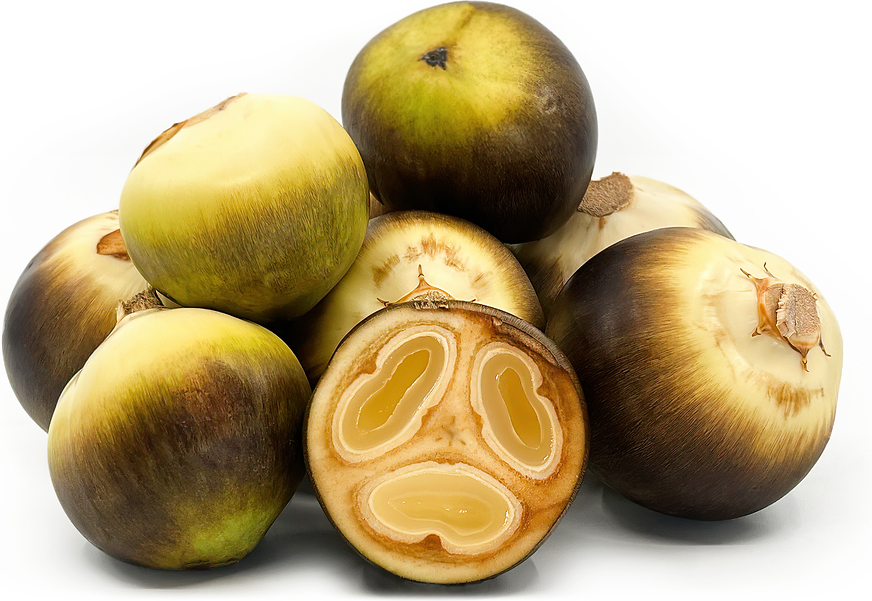


Munjal Fruit
Estimated Inventory, lb : 0
Description/Taste
The Munjal is an oval-shaped fruit that grows in bunches on Palmyra palm trees. The Palmyra palm tree can grow to 30 meters in height, and produces about 50 fruits at a time. Each Munjal fruit is around 15 to 20 centimeters in diameter, and has a hard, purple-black outer shell that resembles the husk of a coconut. The interior is composed of tough white fibers and yellow-orange pulp, and each fruit contains 1 to 3 central seed kernels, which are the most sought after sections for consumption. The young Munjal’s seed kernals are transluscent and hollow, with a soft, jelly-like consistency much like lychees. Their texture is chewy, and they have a slightly nutty flavor. When the Munjal fruit is mature, the seed is solid and resembles hard coconut meat.
Seasons/Availability
Munjal fruit is available year-round, with a peak season in summer
Current Facts
Munjal fruit comes from the Palmyra palm tree and is botanically classified as Borassus flabellifer. It is a member of the sugar palm group. Munjals are also referred to as Sugar Palm fruit, Sea Coconuts, and Ice Apples. The fruits are prized for their edible, gelatinous kernels surrounded by a juicy pulp. Similar to coconuts, Munjal fruit is used as a hydrating treat, as they contain a decent amount of water.
Nutritional Value
Munjal fruit is loaded with minerals like potassium, phosphorus, calcium, and iron. The fruit also contains small doses of vitamins A, B and C. The fruit is a source of phytochemical anthocyanin, which has antioxidant and anti-inflammatory properties.
Applications
Munjal fruits are eaten raw, or are used in desserts. The gelatinous part of the fruit can be cut into pieces and eaten with milk and honey. It also pairs well in fruit salads along with other tropical fruits like mango, pineapple, papaya, kiwi, orange and coconut. Munjal fruits can be blended with coconut water and nut milk in shakes. They go well with flavor complements like cinnamon, cardamom, rose water and lime. Munjals should be consumed as soon as the coconut-like husk is removed. However, if each fruit section can be scooped out of the fibrous layer of the fruit with the fibrous skin encasing each pod intact, these can be stored in a refrigerator. The fruit tends to become rubbery and the sugar ferments, changing the taste of the fruit, once exposed to air. Stored fruit should be eaten within 24 hours.
Ethnic/Cultural Info
Munjal is a summer fruit that is sold by street vendors in India, Vietnam, Cambodia and Thailand. In India, the Munjal is used in traditional medicine, where it is known for its cooling properties. It is used as a digestive aid, and features in cures for skin irritations such as acne and heat rashes. A poultice may be made from the fruit, and used topically on the skin. Many parts of the Palmyra plant are used in rural communities in India. An alcoholic drink known as arrack is made from the sap of the tree, obtained by tapping the Palmyra palm tree. The sap is also used to make jaggery, or palm sugar. Palmyra palm tree leaves are used to make thatched roofs, and can be used for woven goods.
Geography/History
Munjal fruit is found in the tropical and coastal regions of middle and southern India, where it is believed to have originated. There is evidence that the fruit was first cultivated over 1,000 years ago. Today, Munjal fruit is found throughout Tamil Nadu, Maharastra, Goa and Kerala. The Palmyra palm tree that produces the Munjal fruit also grows in Southeast Asia in Cambodia, Vietnam, Thailand, Malaysia and Singapore. It is also found in parts of tropical Africa, and even in Hawaii and Florida. The hardy Palmyra palm thrives in warm climates and well-drained, sandy soils.
Recipe Ideas
Recipes that include Munjal Fruit. One
| Simple Indian Recipes |
|
Toddy Palm Shake |
| Sailu's Kitchen |
|
Toddy Palm Seeds Summer Dessery |
| YouTube |
|
Palm Fruit Rose Milk |
| YouTube |
|
Palm Fruit Cooler |














